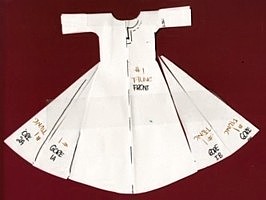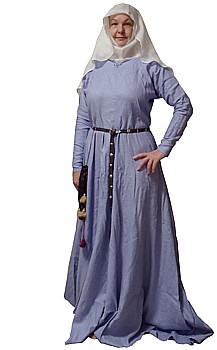|

Sewing
& How To Tutorials
Basic D.I.Y. Medieval Clothing Patterns & Finishing
techniques,
Some Basic Woodworking and Some Miscellaneous Things.

These pages
are aimed at basic patterning and some of these patterns are
not aimed at historical costumers or re-enactors. A couple
of the patterns are quite good for re-enactor ladies. They will
give quite usable and relatively accurate clothes for stallholders
or members of the public attending an event who want to have decent,
basic clothes which look right, avoid the pitfalls of fussy, unnecessarily
complicated commercial patterns.
They can be made in solid linen/cotton blends for stallholders
or made for nobles in brocaded fabrics or dupion silk. Even a
very basic pattern looks completely different when an upmarket
fabric is used, which is especially true of the Easy and Early
Tunic patterns.
The woodworking
tutorials are not using historically accurate construction methods
or tools and are a guide to getting started and making something
better than a plastic esky for storage.
Sewing
Tutorials
- EASY
CHEATY T- TUNIC TUTORIAL - How to make a basic cheaty
medieval gown.
- EASY
T-TUNIC TUTORAL - Mostly historically accurate and
easy to upgrade in the future.
- EASY
13TH CENTURY TUNIC TUTORIAL - How to make an overgown
with short, wide sleeves.
- EASY
WIDE-SLEEVE GOWN TUTORIAL - How to make an overgown
with really big sleeves.
- BASIC
EASY LACED GOWN TUTORIAL - How to make a basic gown
with front lacing.
- KIRTLE
OR GOWN TUTORIAL - How to make a medieval dress with
buttons.
- LADIES
HOSE TUTORIAL - How to make hose based on the London
hose pattern.
- EASY
HOOD TUTORIAL - How to make an early medieval hood.
- HOOD
WITH SHOULDER GORES TUTORIAL - How to make a 14th
or 15th century hood.
- BASIC
SURCOTE TUTORIAL - How to make a surcote with 4 seams.
- SIDELESS
SURCOTE TUTORIAL - How to make a sideless surcote
with gores.
- NOBLE
LADY SIDELESS SURCOTE TUTORIAL - How to make a noblewoman's
sideless surcote.
- BARBETTE
& FILLET - How to make an early 14th century
barbette
- FILLET
- PLAIN, TO PIN A VEIL ONTO - under construction
- FILLET-
FRILLED, FOR USE WITH BARBETTE - How to make a Manesse
Codex-style fillet.
- FILLET-
PLEATED, FOR USE WITH BARBETTE - under construction
- FILLET
- SILK WITH DECORATION - How to make a fancy silk
circlet - under construction

Finishing
Techniques Tutorials
- EYELET
MAKING TUTORIAL - How to make eyelets
- BUTTONHOLE
MAKING TUTORIAL - How to make buttonholes
- CLOTH
BUTTON MAKING TUTORIAL - How to make buttons to match
your clothes
- LUCET
CORD TUTORIAL - Making lacing cord for your gown
- TASSEL
MAKING TUTORIAL - How to make tassels
- HOW
TO DO FICHETS - How I made them

Other
How-To-Make tutorials
- MAKE
FAKE BRAIDS - for 14th century hairstyles
- FALSE
HAIRPIECE TUTORIAL - PLAITED BUNS - 14th century
style
- MAKE
VEIL PINS - the cheaty way
- MAKE
A MEDIEVAL CHEST - non-historical methods & tools
- MAKE
A MEDIEVAL STOOL OR POT STAND - non historical methods
& tools

Crisis
Help Tutorials
- HOW
TO CLEAN A MUDDY HEM The post-event clean up for
your train

 IMPORTANT
THINGS TO NOTE! IMPORTANT
THINGS TO NOTE!
These pattern
cutting guides are not actual measurements.
When using as cotton shirt to make your own pattern, make sure
it's not a stretchy shirt or your fabric will not stretch the
same way.
ALL of these patterns will require a certain amount of
taking in and pinning once they have been cut. This will give
you a custom fit to make it fit your own body shape. Medieval
people did it that way.
I use these pattern guides myself for things that I wear and they
only fit so nicely because I pin them in to fit after the basic
fabric has been cut. Otherwise, yes. They hang like a sack.
I can't stress this enough... if in doubt, cut a little bigger.
You can always pin in, but it's very hard to adjust something
if it's cut too small.

Copyright
© Rosalie Gilbert
All text & photographs within this site are the property of
Rosalie Gilbert unless stated.
Art & artifact images remain the property of the owner.
Images and text may not be copied and used without permission.
|